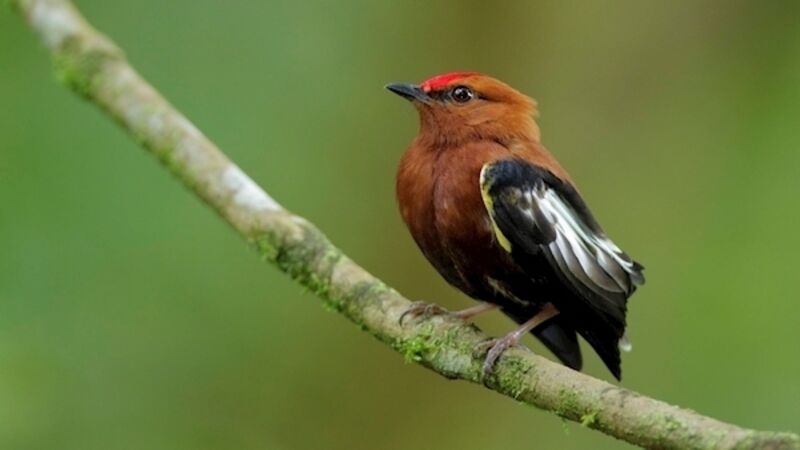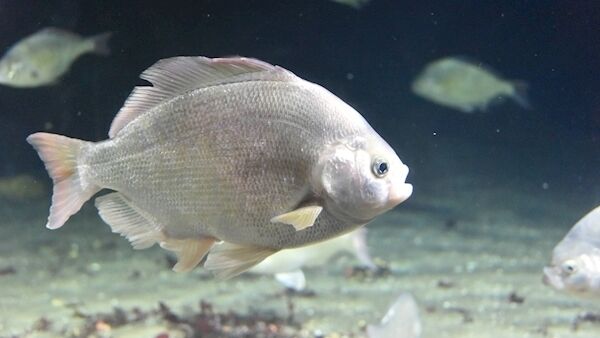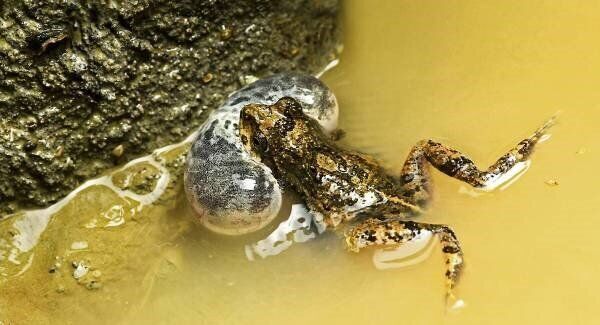The beauty and unusual beasts of nature

The extravagant splendour of the animal kingdom is prompting scientists to rethink evolution, writes
A male flame bowerbird is a creature of incandescent beauty. The hue of his plumage transitions seamlessly from molten red to sunshine yellow. But that radiance is not enough to attract a mate.
When males of most bowerbird species are ready to begin courting, they set about building the structure for which they are named: an assemblage of twigs shaped into a spire, corridor or hut.
They decorate their bowers with scores of colourful objects, like flowers, berries, snail shells or, if they are near an urban area, bottle caps and plastic cutlery.
Some bowerbirds even arrange the items in their collection from smallest to largest, forming a walkway that makes themselves and their trinkets all the more striking to a female — an optical illusion known as forced perspective that humans did not perfect until the 15th century.
Yet even this remarkable exhibition is not sufficient to satisfy a female flame bowerbird. Should a female show initial interest, the male must react immediately.
Staring at the female, his pupils swelling and shrinking like a heartbeat, he begins a dance best described as psychotically sultry. He bobs, flutters, puffs his chest.
He crouches low and rises slowly, brandishing one wing in front of his head like a magician’s cape. Suddenly his whole body convulses like a windup alarm clock.
If the female approves, she will copulate with him for two or three seconds. They will never meet again.
The bowerbird defies traditional assumptions about animal behaviour.
Here is a creature that spends hours meticulously curating a cabinet of wonder, grouping his treasures by colour and likeness. Here is a creature that single-beaked builds something far more sophisticated than many celebrated examples of animal toolmaking; the stripped twigs that chimpanzees use to fish termites from their mounds pale in comparison.
The bowerbird’s power, as at least one scientist has argued, is nothing less than art.
Adaptations are meant to be useful — that’s the whole point — and the most successful creatures should be the ones best adapted to their particular environments. So what is the evolutionary justification for the bowerbird’s ostentatious display?
Not only do the bowerbird’s colorful feathers and elaborate constructions lack obvious value outside courtship, but they also hinder his survival and general well-being, draining precious calories and making him much more noticeable to predators.
Numerous species have conspicuous, metabolically costly and physically burdensome sexual ornaments, as biologists call them. To reconcile such splendor with a utilitarian view of evolution, biologists have favored the idea that beauty in the animal kingdom is not mere decoration — it’s a code.
According to this theory, ornaments evolved as indicators of a potential mate’s advantageous qualities: its overall health, intelligence and survival skills, plus the fact that it will pass down the genes underlying these traits to its children.
A bowerbird with especially bright plumage might have a robust immune system, for example, while one that finds rare and distinctive trinkets might be a superb forager. Beauty, therefore, would not confound natural selection — it would be very much a part of it.
Charles Darwin himself disagreed with this theory. Although he co-discovered natural selection and devoted much of his life to demonstrating its importance, he never claimed that it could explain everything. Ornaments, Darwin proposed, evolved through a separate process he called sexual selection: Females choose the most appealing males “according to their standard of beauty” and, as a result, males evolve toward that standard, despite the costs.
Although never completely forgotten, Darwin’s theory of beauty was largely abandoned.
Now, nearly 150 years later, a new generation of biologists is reviving Darwin’s neglected brainchild. Beauty, they say, does not have to be a proxy for health or advantageous genes. Sometimes beauty is the glorious but meaningless flowering of arbitrary preference.
These biologists are not only rewriting the standard explanation for how beauty evolves; they are also changing the way we think about evolution itself. For decades, natural selection — the fact that creatures with the most advantageous traits have the best chance of surviving and multiplying — has been considered the unequivocal centrepiece of evolutionary theory.
But these biologists believe that there are other forces at work, modes of evolution that are much more mischievous and discursive than natural selection.
Perhaps no living scientist is as enthusiastic — or doctrinaire — a champion of Darwinian sexual selection as Richard Prum, an evolutionary ornithologist at Yale University. In May 2017, he published a book, The Evolution of Beauty that lucidly and passionately explains his personal theory of aesthetic evolution.

It was nominated for the Pulitzer Prize for general nonfiction, but within the scientific community, Prum’s ideas have not been as warmly received. Again and again, he told me, he has asked other researchers for feedback and received either excuses of busyness or no reply at all. Some have been openly critical. In the early 1980s, while researching the history of sexual selection, Prum read a seminal 1915 paper and a 1930 book on the subject by the English biologist and statistician Ronald Fisher. At first, Fisher argued, females might evolve preferences for certain valueless traits, like bright plumage, that just happened to correspond with health and vigour.
Their children would tend to inherit the genes underlying both their mother’s preference and their father’s trait. Over time, this genetic correlation would reach a tipping point, creating a runaway cycle that would greatly exaggerate both preference and trait, glorifying beauty at the expense of the male’s survival.
In the early 1980s, the American evolutionary biologists Russell Lande and Mark Kirkpatrick gave Fisher’s theory a formal mathematical girding, demonstrating quantitatively that runaway sexual selection could happen in nature and that the ornaments involved could be completely arbitrary, conveying no useful information whatsoever.
Although Fisherian selection was certainly not ignored, it was ultimately overshadowed by a series of hypotheses that seemed to rescue beauty from purposelessness. First, the Israeli biologist Amotz Zahavi proposed a counterintuitive idea called the handicap principle.
Extravagant ornaments, Zahavi argued, were not merely indicators of advantageous traits as Wallace had said — they were a kind of test. If an animal thrived despite the burden of an unwieldy or metabolically expensive ornament, then that animal had effectively demonstrated its vigour and proved itself worthy of a mate.
Similarly, in 1982, the evolutionary biologists W. D. Hamilton and Marlene Zuk proposed that some ornaments, in particular bright plumage, signalled that a male was resilient against parasites and would grant his children the same protection.
Many scientists began to think of sexual selection as a type of natural selection. Scores of researchers joined the hunt for measurable benefits of choosing an attractive mate: both direct benefits, like better parenting or more desirable territory, and indirect benefits, in particular some evidence that more alluring males really did have ‘’good genes’’ underlying various desirable qualities, like resistance to disease or higher-than-average intelligence.
After more than 30 years of searching, most biologists agree that although these benefits exist, their prevalence and importance is uncertain. Prum thinks the evidence for the heritable benefits of choosing a beautiful mate is scant because such benefits are themselves rare, whereas arbitrary beauty is “nearly ubiquitous.”
Over the years, the more he contemplated runaway selection, the more convinced he became that it was a far more powerful and creative evolutionary force than natural selection, which he regards as overhyped and boring. “Animals are agents in their own evolution,” he told me during one conversation.
Birds are beautiful because they are beautiful to themselves.
Prum still stings from the perceived scorn of his academic peers. But after speaking with numerous researchers in the field of sexual selection, I learned that all of Prum’s peers are well aware of his work and that many already accept some of the core tenets of his argument: namely that natural and sexual selection are distinct processes and that, in at least some cases, beauty reveals nothing about an individual’s health or vigor.
At the same time, nearly every researcher I spoke to said that Prum inflates the importance of arbitrary preferences and Fisherian selection to the point of eclipsing all other possibilities.
Like Darwin, Prum is so enchanted by the outcomes of aesthetic preferences that he mostly ignores their origins. Toward the end of our bird walk at Hammonasset Beach State Park, we got to talking about club-winged manakins.
I asked him about their evolutionary history. Prum thinks that long ago, an earlier version of the bird’s courtship dance incidentally produced a feathery susurration.
Over time, this sound became highly attractive to females, which pressured males to evolve adaptations that made their rustling feathers louder and more noticeable, culminating in a quick-winged strumming. But why, I asked Prum, would females be attracted to those particular sounds in the first place?
To Prum, it was a question without an answer — and thus a question not worth contemplating. “Not everything,” he said, “has this explicit causal explanation.”
Prum’s indifference to the ultimate source of aesthetic taste leaves a conspicuous gap in his grand theory. Even if we were to accept that most beauty blooms from arbitrary preferences, we would still need to explain why such preferences exist at all.
It’s entirely conceivable that an animal might be inherently partial to, say, a warbling mating call or bright yellow feathers, and that these predilections would have nothing to do with advantageous genes.

Yet such inclinations are inarguably the product of an animal’s neurobiology, which is itself the result of a long evolutionary history that has adapted the animal’s brain and sensory organs to specific environmental conditions.
In the past two decades, a cohort of biologists have dedicated themselves to studying how an animal’s “sensory bias” — its ecological niche and its particular way of experiencing the world — sculpts its appearance, behaviour and desires. Like Prum, they don’t think beauty has to be adaptive. But where Prum celebrates caprice, they seek causality.
Molly Cummings, a professor of integrative biology at the University of Texas at Austin, is a leading researcher in the field of sensory ecology. For several years, she studied various species of surfperch, repeatedly diving in kelp forests with a Plexiglas-protected spectrometer to quantify and characterise the light in different habitats.
After hundreds of dives and careful measurements, Cummings discovered that water itself had guided the evolution of piscine beauty. A female’s preference for a blaze of silver or blue was not arbitrary; it was a consequence of the particular wavelengths of light that traveled farthest through her underwater niche. Whichever males happened to have scales that best reflected these wavelengths were more likely to catch the eye of females.
In her studies, Cummings showed that surfperch living in dim or murky waters generally preferred shiny ornaments, while surfperch inhabiting zones of mercurial brightness favoured bold colours.
Later, Cummings found that Mexican swordtails occupying the upper layers of rivers, where the clear water strongly polarised incoming sunlight, had ornaments that were specialized to reflect polarised light — like a stripe of iridescent blue. “Some people think female preferences just somehow emerge,” Cummings says, “but what has been overlooked is that in many cases, it’s a result of environmental constraints. It’s not always random.”
What a creature finds attractive depends on more than the unique qualities of its environment, however; attraction is also defined by which of those qualities cross the threshold of awareness.
Michael Ryan, a professor of zoology whose lab and office are just a few floors below Cummings’, has spent more than 30 years investigating how the quirks of an animal’s anatomy determine its aesthetic preferences — a career he details in his recent book, A Taste for the Beautiful.
Since 1978, Ryan has been traveling to Panama to study a mud-colored frog called the túngara. The túngara has a unique form of beauty that is not visual but aural. At dusk, male túngara frogs gather at the edges of puddles and sing to seduce females.
Their mating call has two elements: The main part, dubbed the whine, sounds precisely like a miniaturised laser gun; sometimes this is followed by one or more brief barks, known as chucks. A long and complex mating call is risky: It attracts frog-eating bats. Yet there is a high payoff. Ryan has shown that whines followed by chucks are up to five times as appealing to females as whines alone.
But why?
As it happens, larger males, which produce the deepest and sexiest chucks, are also the most adept at mating, because they are closer in size to females. Moreover, the túngara frog has an inner organ tuned to 2,200 hertz, which is close to the dominant frequency of a chuck.
Together, these facts seem to indicate the túngara’s puddle-side serenade is an example of adaptive mate choice: Females evolved ears tuned to chucks because they indicate the biggest and most sexually skilled males.

Ryan’s research revealed a stranger story. When he examined the túngara frog’s family tree, he discovered that eight frog species closely related to the túngara also have inner ear organs sensitive to frequencies of about 2,200 hertz, yet none of them produce chucks in their mating call.
Ryan thinks that eons ago, the ancestor of all these species probably evolved an inner ear tuned to roughly 2,200 hertz for some long-abandoned purpose.
The túngara later revived this neglected auditory channel, probably by happenstance. Male frogs that happened to burp out a few extra notes after whining were automatically favoured by females — not because they were more suitable mates, but simply because they were more noticeable.
Like the glistening scales on the surfperch and swordtails that Cummings studied, the túngara’s costly mating call did not evolve to convey any pragmatic information about health or fitness. But that doesn’t mean that these traits were arbitrary.
“I took a real beating when I suggested this idea in 1990,” Ryan says.
It was very widely criticised. But now sensory bias is considered an important part of the evolution of these preferences.
Prum says sensory bias could not possibly explain the staggering diversity and idiosyncrasy of sexual ornaments — the fact that every closely related sparrow species has a unique embellishment, for example. He sees sensory bias as just another way to maintain the predominant “adaptive paradigm” that refuses to acknowledge his theory of aesthetic evolution. Tellingly, Prum and Ryan do not discuss each other’s work in their recent books.
Most of the scientists I spoke with said the old dichotomy between adaptive adornment and arbitrary beauty, between “good genes” and Fisherian selection, is being replaced with a modern conceptual synthesis that emphasises multiplicity.
“Beauty is something that arises from a host of different mechanisms,” says Gil Rosenthal, an evolutionary biologist at Texas A&M University and the author of the new scholarly tome “Mate Choice.” “It’s an incredibly multilayered process.”
The environment constrains a creature’s anatomy, which determines how it experiences the world, which generates adaptive and arbitrary preferences, which loop back to alter its biology, sometimes in maladaptive ways.
Beauty reveals that evolution is neither an iterative chiseling of living organisms by a domineering landscape nor a frenzied collision of chance events.
Rather, evolution is an intricate clockwork of physics, biology and perception in which every moving part influences another in both subtle and profound ways. Its gears are so innumerable and dynamic — so susceptible to serendipity and mishap — that even a single outcome of its ceaseless ticking can confound science for centuries.
Adapted from an article that appeared in The New York Times Magazine.















